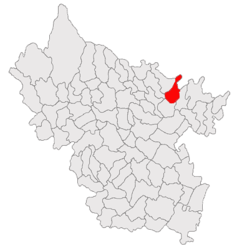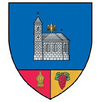| Râmnicu Sărat | |
|---|---|
| Municipality | |
 Râmnicu Sărat town hall Râmnicu Sărat town hall | |
 Coat of arms Coat of arms | |
 Location in Buzău County Location in Buzău County | |
 | |
| Coordinates: 45°22′48″N 27°3′36″E / 45.38000°N 27.06000°E / 45.38000; 27.06000 | |
| Country | Romania |
| County | Buzău |
| Government | |
| • Mayor (2020–2024) | Sorin-Valentin Cîrjan (PSD) |
| Area | 8.77 km (3.39 sq mi) |
| Elevation | 118 m (387 ft) |
| Population | 29,774 |
| • Density | 3,400/km (8,800/sq mi) |
| Time zone | EET/EEST (UTC+2/+3) |
| Postal code | 125300 |
| Area code | (+40) 02 38 |
| Vehicle reg. | BZ |
| Website | primariermsarat |
Râmnicu Sărat (also spelled Rîmnicu Sărat, Romanian pronunciation: [ˌrɨmniku səˈrat], German: Rümnick or Rebnick; Turkish: Remnik) is a city in Buzău County, Romania, in the historical region of Muntenia. It was first attested in a document of 1439, and raised to the rank of municipiu in 1994.
The city rises from a marshy plain, east of the Carpathian Mountains, and west of the cornlands of southern Moldavia. It lies on the left bank of the river Râmnicul Sărat. Salt and petroleum are worked in the mountains, and there is a considerable trade in agricultural produce and preserved meat.
Population
| Year | Pop. | ±% |
|---|---|---|
| 1859 | 5,707 | — |
| 1900 | 13,134 | +130.1% |
| 1912 | 14,496 | +10.4% |
| 1930 | 15,007 | +3.5% |
| 1948 | 19,267 | +28.4% |
| 1956 | 19,095 | −0.9% |
| 1966 | 22,336 | +17.0% |
| 1977 | 28,689 | +28.4% |
| 1992 | 41,405 | +44.3% |
| 2002 | 38,805 | −6.3% |
| 2011 | 31,256 | −19.5% |
| 2021 | 29,774 | −4.7% |
| Source: Census data | ||
History
Râmnicu Sărat was the scene of battles between the Wallachians and Ottomans in 1634, 1434, and 1573.
It was also here that, in 1789 (during the Russo-Turkish War of 1787–1792), an army of Imperial Russian and Habsburg troops, commanded by Alexander Suvorov, defeated the Ottoman forces in the Battle of Rymnik. For this victory, Suvorov was awarded the victory title of "Count of Rymnik" or "Rimniksky" (граф Рымникский) by empress Catherine the Great of Russia.
In 1854, Râmnicu Sărat was almost destroyed by fire and was rebuilt. From 1864 to 1950 (with the exception of 1938–1940), the city was the seat of Râmnicu Sărat County. From 1901 to 1963, the Râmnicu Sărat Prison operated in the city.
Educational institutions
- Alexandru Vlahuță National College
- Ștefan cel Mare Theoretical High School
- Elina Matei Basarab Technological Economic High School
- Victor Frunză Technological High School
- Traian Săvulescu Technological High School
Natives
- Petre Antonescu
- Mariana Bitang
- Romeo Bunică
- Kid Cann
- Nicolae Ciupercă
- Nicolae Fleva
- Ioan Glogojeanu
- Petre Iorgulescu-Yor
- Damian Militaru
- Nicolae Minovici
- Ștefan Minovici
- Costin Murgescu
- Leonida Nedelcu
- Eduard Nicola
- Adrian Oțoiu
- Ștefan Petrescu
- Traian Săvulescu
- Saul Steinberg
- Nicu Stoian
- Marius Tigoianu
Gallery
-
 The Râmnicu Sărat train station, designed by Anghel Saligny
The Râmnicu Sărat train station, designed by Anghel Saligny
-
 The Battle of Rymnik battlefield
The Battle of Rymnik battlefield
-
Alexandru Vlahuță National College
-
Church of the Assumption of Virgin Mary, built by Constantin Brâncoveanu in 1697
References
- "Results of the 2020 local elections". Central Electoral Bureau. Retrieved 16 June 2021.
- "Populaţia rezidentă după grupa de vârstă, pe județe și municipii, orașe, comune, la 1 decembrie 2021" (XLS). National Institute of Statistics.
- of whom 1,500 were Jews, Chisholm, Hugh, ed. (1911). "Râmnicu Sarat" . Encyclopædia Britannica. Vol. 22 (11th ed.). Cambridge University Press. p. 877.
